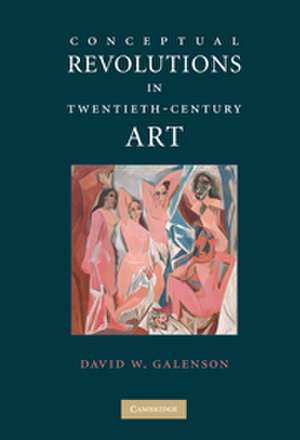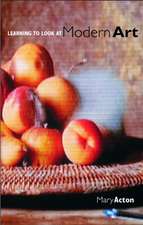Conceptual Revolutions in Twentieth-Century Art
Autor David W. Galensonen Limba Engleză Hardback – 27 sep 2009
| Toate formatele și edițiile | Preț | Express |
|---|---|---|
| Paperback (1) | 326.31 lei 6-8 săpt. | |
| Cambridge University Press – 13 sep 2009 | 326.31 lei 6-8 săpt. | |
| Hardback (1) | 749.20 lei 6-8 săpt. | |
| Cambridge University Press – 27 sep 2009 | 749.20 lei 6-8 săpt. |
Preț: 749.20 lei
Preț vechi: 871.16 lei
-14% Nou
Puncte Express: 1124
Preț estimativ în valută:
143.36€ • 150.08$ • 118.62£
143.36€ • 150.08$ • 118.62£
Carte tipărită la comandă
Livrare economică 05-19 aprilie
Preluare comenzi: 021 569.72.76
Specificații
ISBN-13: 9780521112321
ISBN-10: 052111232X
Pagini: 460
Ilustrații: 25 tables
Dimensiuni: 156 x 235 x 30 mm
Greutate: 0.75 kg
Editura: Cambridge University Press
Colecția Cambridge University Press
Locul publicării:New York, United States
ISBN-10: 052111232X
Pagini: 460
Ilustrații: 25 tables
Dimensiuni: 156 x 235 x 30 mm
Greutate: 0.75 kg
Editura: Cambridge University Press
Colecția Cambridge University Press
Locul publicării:New York, United States
Cuprins
Introduction; 1. The back story of twentieth-century art; 2. The greatest artists of the twentieth century; 3. The most important works of art of the twentieth century; 4. The greatest artistic breakthroughs of the twentieth century; 5. The greatest women artists of the twentieth century; 6. Creating new genres: conceptual artists at work and play in the twentieth century; 7. And now for something completely different: the versatility of conceptual innovators; 8. You cannot be serious: the conceptual innovator as trickster; 9. Painting by proxy: the conceptual artist as manufacturer; 10. Co-authoring advanced art; 11. Language in visual art; 12. Portraits of the artist: personal visual art in the twentieth century; 13. The rise and (partial) fall of abstract painting in the twentieth century; 14. The globalization of advanced art in the twentieth century; 15. Artists and the market: from Leonardo and Titian to Warhol and Hirst; 16. The state of advanced art: the late twentieth century and beyond.
Recenzii
“To Mr. Galenson markets are what make the 20th century completely different from other eras for art. . . . [B]reaking the rules became the most valued attribute. The greatest rewards went to conceptual innovators who frequently changed styles and invented genres.” – Patricia Cohen, The New York Times
“David Galenson brings the insights of an economic historian to this fascinating study of innovation in modern art. He shows how changes in the structure of the market for new art altered the innovation process itself and how the nature of innovation developed in the lives of many 20th century artists. Anyone interested in the development of 20th century art and any economist interested in the general process of innovation will want to read this book.” – Martin Feldstein, Department of Economics, Harvard University
"With this book, David Galenson burnishes his reputation as one of the most interesting economists at work today. Once you've read Conceptual Revolutions in Twentieth-Century Art, you'll never look at modern art – or the creative process – quite the same way." – Daniel H. Pink, author of A Whole New Mind
“David Galenson has written the most inventive, surprising, and illuminating book on modern art to appear in my lifetime. I can think of no other book on modern art that remotely resembles Conceptual Revolutions in Twentieth-Century Art. Yet it is a surprising book because Galenson draws much of his evidence from what artists and art historians have been saying about modern art for more than a century. What Galenson has done is to take often over-familiar material and to reshape it by asking simple questions about artists’ behavior and then systematically setting out to explain them. Most importantly, I know of no artist, and certainly no art historian, who has seen so clearly the connection between the variety and pace of 20th-century artistic innovations and the increasing autonomy granted to artists by a richly competitive market. After introductory chapters on innovation and artistic importance, Conceptual Revolutions describes with unsurpassed clarity artistic behaviors new to recent art. Each chapter can be read independently of the others, but taken together readers will find clearly explained much of what often seems mysterious not only to the layperson but even to the art professional. Conceptual Revolutions offers new explanations for many familiar phenomena in modern art and challenges many received ideas held by scholars of 20th-century art, all presented in a prose style that is accessible to any intelligent reader. Conceptual Revolutions should change any open-minded reader’s basic perceptions about art today.” – Robert Jensen, Department of Art, University of Kentucky
“A fascinating and highly readable explanation of why the art of the 20th century changed so dramatically from that which came earlier. David Galenson goes further in using innovative methods of analysis to change our concept of modern art than anyone I know. Entertaining and informative.” – Don Thompson, author of The $12 Million Stuffed Shark: The Curious Economics of Contemporary Art
“David Galenson brings the insights of an economic historian to this fascinating study of innovation in modern art. He shows how changes in the structure of the market for new art altered the innovation process itself and how the nature of innovation developed in the lives of many 20th century artists. Anyone interested in the development of 20th century art and any economist interested in the general process of innovation will want to read this book.” – Martin Feldstein, Department of Economics, Harvard University
"With this book, David Galenson burnishes his reputation as one of the most interesting economists at work today. Once you've read Conceptual Revolutions in Twentieth-Century Art, you'll never look at modern art – or the creative process – quite the same way." – Daniel H. Pink, author of A Whole New Mind
“David Galenson has written the most inventive, surprising, and illuminating book on modern art to appear in my lifetime. I can think of no other book on modern art that remotely resembles Conceptual Revolutions in Twentieth-Century Art. Yet it is a surprising book because Galenson draws much of his evidence from what artists and art historians have been saying about modern art for more than a century. What Galenson has done is to take often over-familiar material and to reshape it by asking simple questions about artists’ behavior and then systematically setting out to explain them. Most importantly, I know of no artist, and certainly no art historian, who has seen so clearly the connection between the variety and pace of 20th-century artistic innovations and the increasing autonomy granted to artists by a richly competitive market. After introductory chapters on innovation and artistic importance, Conceptual Revolutions describes with unsurpassed clarity artistic behaviors new to recent art. Each chapter can be read independently of the others, but taken together readers will find clearly explained much of what often seems mysterious not only to the layperson but even to the art professional. Conceptual Revolutions offers new explanations for many familiar phenomena in modern art and challenges many received ideas held by scholars of 20th-century art, all presented in a prose style that is accessible to any intelligent reader. Conceptual Revolutions should change any open-minded reader’s basic perceptions about art today.” – Robert Jensen, Department of Art, University of Kentucky
“A fascinating and highly readable explanation of why the art of the 20th century changed so dramatically from that which came earlier. David Galenson goes further in using innovative methods of analysis to change our concept of modern art than anyone I know. Entertaining and informative.” – Don Thompson, author of The $12 Million Stuffed Shark: The Curious Economics of Contemporary Art
Notă biografică
Descriere
Galenson combines social scientific methods with qualitative analysis to produce a new interpretation of modern art.






